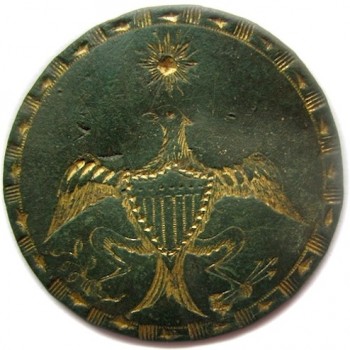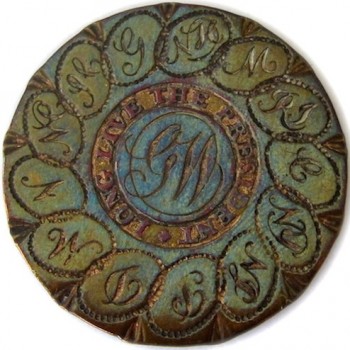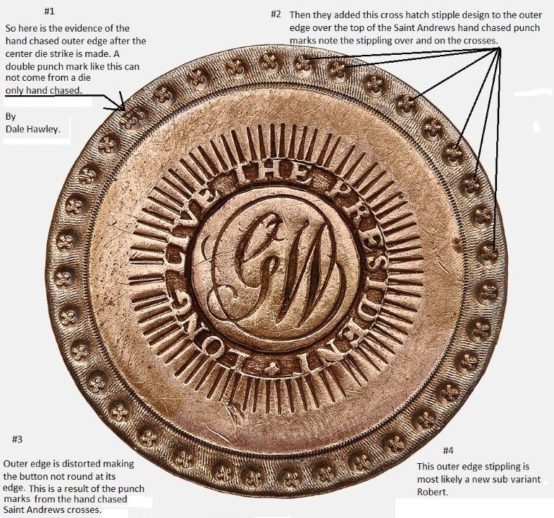
GWI 24-A
Isabela’s Scottish Diamond
********
“When I began Collecting 20 Years Ago, Albert noted around 650 Specimens
Today through our Library Submissions I estimate the count at 1800.
”
******** ******** *******
There are only 2 “Master” Hand-Engraved, and 3 (Poss. 4-GWI 3) Hand chased buttons known to exist. They are all the works Robert Scot and his Philadelphia Artisans. These GWI and NNT button artisans were all celebrated and accomplished artists of their era. They had created many of America’s federal and state insignias and other state official engravings for seals and military items such as militia flags. These artisans were highly educated from a very young age under apprenticeship of a master, and used their skills to reflect their education into ancient history and religion.
They were able to use their talents in a broad spectrum of mediums and not just confine it to a specific venue such as paintings. With the Master copies on steel die hubs or the finished button itself they were able to embellish their final workings as a writer crafts his words in a final revision of his earlier works. As button collectors we use terms like “Hand-Chasing” without understanding the artist himself trying to tweak his already accepted works. I
As with George Washington Inaugurals and New Nation tribute buttons the steel dies were specifically engraved in such a way that is already enclosed a special illusion to it’s intended meaning. The hand chased addition would be only to give the outward designs the extra finishing touches to make the button stand-out in an extraordinary fashion. All the buttons that are noted to be hand chased were embellished after the button design was stamped into the planchet.

Isabela’s Blue Diamond
GWI 4-B.1
These variants are, GWI 4-B.1, GWI 4-B.2, and GWI 6. In GWI 4-B.2, the “Three Roads of Prosperity” was added to the legend. In GWI 4-B.1 it depicts the Operative Mason Symbol Mark tribute in 11th Century Scottish Dunkfeld Cathedral. These symbols were hand chased in the legend as a salute to noted operative masons. As Dale noted in his graph below with GWI 6, the artisan added the Scottish St. Andrew’s Cross was added to the wells circles running around the legend along with stippling not found on the regular variants. This extra artist embellishment was added to the process after the button was produced. Meaning, there might have been two dies for this variant. After the steel die was created, the artist hand chased a finished model and then decided to go back and recreate another die with these added embellishments. Using the original die would not have been an option because once the steel die is tempered by the action of the furnace, the steel would have been hardened for his tools to cut into it. So, there likely was a variant at one point which didn’t have the added religious tribute of the Saint Andrew’s Cross in the legends wells.

GWI 6-B
Saint Andrews Cross & Added Stippling
Hand chased buttons are different then Hand-Engraved buttons, Hand engraved buttons means using the engravers tools directly on the blank planchet. Usually, these brass or copper disks are soft enough to accept an image or cutting. It is unclear to me if the final product is ever fired to temper to hardening strength, but I do not believe so. Even though these do have an artist value onto themselves, this would be an inefficient process for mass production. Most likely with these Philadelphia artisans they would have drawn detailed sketches in-order to place the intended illusions within the designs. Prototypes for their own review of the designs finished works would have been fathomable and reasonable to assume. these prototypes would not have been marked to the public and only shared between the artisans working on the project.
There is only one GWI and one NNT button thought to be a prototype of sorts. GWI 24-A The Heraldic Eagle W/Inverted Diamond Border Indentees. This button was thought to be worked on by James Trenchard on his trip to England. Since, a second specimen was dug in England in 2016, one can easily conclude the original art was transferred to a steel die for limited production purposes. The second is the Sons of Liberty propaganda tribute NNT 26, The Liberty (Phrygian Cap) on a Roman Pole (To take a Stand). There is only two specimens known as of 2018. Since it’s use was noted to be used for a Philadelphia statesman, the second could have been made as a matching cuff, or made for a friend who admired the first. In my opinion, these two buttons are some of the Most Important American Historical Buttons known to exist outside of GWI 21-B.
* To date there have been no original steel dies found or known to exist.
1) R-7 1 or 2 Known to Exist > GWI 3, GWI 4-B.1, GWI 4-D, GWI 7-A,B,C,D, GWI 13-B, GWI 14 A , B & C, GWI 16, GWI 17, GWI 19-A, B, &C, GWI 21-A&B, GWI 24-A, GWI 26, GWI 28 – These Buttons should command the Highest Values.
2) R-6 3 to 5 Known to Exist
3) R-5 6 -10 Known to Exist
4) R-4 11-25 Known to Exist
5) R-3 26-50 Known to Exist
6) R-2 51-75 Known to Exist
7) R-1 76-99 Known to Exist
GWI & NNT Buttons are either a Family Heirloom or Found as a Digger’s Treasure
1) A non-excavated button is one that would have been saved as a family heirloom, a keep sake, or was part of a collector’s coin collection. Only these buttons hold a market’s premium and should.
2) An excavated or dug button is one that was extracted from the ground by someone digging it up. This type of button would have been buried for an unspecified amount of time, and would have succumbed to the earths natural elements that are found in both dirt and ground water.
Most serious collectors consider these less desirable if un-dug specimens are available.